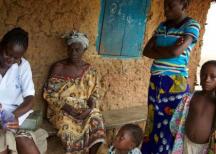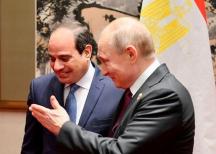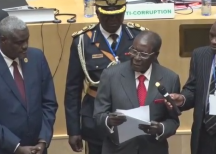
Yash Tandon critiques the Responsibility to Protect (R2P) resolutions within the UN system to show how the forces of Empire have used 'humanitarian intervention' to advance their own interests. He also explains how the militaristic solutions advanced under R2P are part of a neurotic response to the various crises faced by the Empire.
In the last two columns on Libya I made a distinction between colony and neo-colony, going beyond Nkrumah’s initial analysis of neo-colonialism to show that in our times, the contradictions between the neo-colonies and the Empire are increasing in intensity. I argued that the ‘Arab Spring’ is, in essence, not just a challenge to the Arab dictators, but it is, above all, a challenge to the Empire itself.
When the streets revolted against the neo-colonial regimes of North Africa and the Arab world, they were revolting, in effect, against the imperial order that is suffocating their democratic aspirations. In other words, in a larger and indeed more fundamental sense, the Arab Spring is part of a widening and deepening imperial crisis, which includes other aspects of its global economic crisis and the crisis of its legitimacy and moral authority.
IMPERIAL NEUROSIS
A nightmare scenario for the Empire in the Arab region involves three basic ingredients. One is the rise of Iran and what the Empire ‘perceives’ as the Islamic ‘fundamentalist’ threat (the inverted commas are explained below). The second is a change in the balance of power in the region that in the long run is most certainly going against the security and wellbeing of Israel, unless the Empire and Israel make fundamental changes in their dealings with the Palestinians. And the third is the deepening economic crisis within the capitalist system.
The Empire’s understanding and responses to the above triple challenges is neurotic. Neurosis is a condition of mind that is based on an irrational phobia and what is recognised in the medical world as an obsessive-compulsive disorder (OCD). This applies to nations as well as to individuals. With nations, the phobia is real; it has real-time effects, especially if it affects powerful countries, as is the case with the present day Empire.
The triple causes of imperial OCD go back to 1979. That is the year when the Iranian revolution ushered in the era of the Ayatollahs. That was also the year of the beginning of deep recession in the global capitalist system.
Let us, first, take the economic crisis and the Empire’s neurotic response to it. The crisis forced the Empire to review its global economic strategy. Its ‘resolution’ around 1985-86 was the neo-liberal agenda ushered in under the leadership of Thatcher and Reagan, and then ‘globalised’. The question is: what is it about this response that classifies it as neurotic? What made the neo-liberal agenda a neurotic response to the economic challenge? The short answer is that the response is neurotic because it is based on a fierce defence of the capitalist system which has lost its historic justification.
I shall leave a detailed analysis of this complex evolution of the capitalist system for another occasion. Suffice to say here that this particular neurosis has several consequences, two of which are crucial to our analysis here. One is the tightening of control over the political economies of the neo-colonies in the third world. And the second is the emerging disintegration of the Euro-American system. On the second we shall not dwell here, except to say that the 2007/08 crisis was inherent within the very dynamics of the capitalist system. In other words, it was inevitable; given the system’s internal dynamics, the crisis was unavoidable. It is wrongly identified as a ‘financial’ crisis, because in fact it is much deeper. The crisis that the Eurozone faces today, for example, is one of its latest manifestations. It requires no genius to understand that what is taking place in Europe is an increasing control of the German, French and British finance capital over the peripheral nations of Europe such as Greece, Iceland, Portugal and Spain, leading, inevitably, to their own ‘Arab Springs’, i.e. popular revolts against the Empire of finance capital.
As for the first neurotic response - namely, the tightening of control over the political economies of the neo-colonies in the third world - it is more central to our concerns here. For some 30 years, from the 1980s to 2010, the Empire of Finance Capital (EFC) imposed on these countries an economic structural readjustment. This is a vast subject, but its essence consisted of a harsh regime of budgetary controls; trade liberalisation; centralisation of corporate control over the production, financing, marketing, technology and management of the natural resources of the neo-colonies; and monopolisation of scientific knowledge in the form of intellectual property rights (IPRs) vested in the control of transnational corporations. These measures were forced on the recipients of ‘donor funds’ through debt bondage; the so-called ‘development aid’; and the penetration by foreign direct investments (FDIs) through forced capital flow liberalisation.
But why was this ‘neurotic’? What qualifies this action of the Empire as neurotic? It was (and is) neurotic because it was an outcome of an obsessive-compulsive disorder (OCD) in the system, a knee-jerk ‘one solution fits all’ kind of ‘remedy’ imposed on all countries that had become victim to financial and economic distress. It was an illusory attempt to bolster a system of global production and distribution that, as earlier mentioned, had become historically irrational. Secondly, it was principally aimed at resolving Empire’s own internal crisis of decreasing rates of profitability, increasing threats to accessing global natural resources, and, resulting from these, deepening social and class divisions within the imperial countries. It was neurotic, thirdly, because in time, it was to produce, inevitably, a strong counter reaction from millions of people who were thrown into the pitfalls of poverty, unemployment, crime and mass emigration. The ‘Arab Spring’ was inevitable, and has its roots directly linked to this neurotic response of the Empire to try and resolve its deepening internal contradictions.
Equally neurotic is the Empire’s knee-jerk reaction to the challenge of Islamic ‘fundamentalism’, worsened by ‘nine-eleven’. This, too, is a vast subject. It has spawned a vast amount of literature, films, talk-shows, conferences, and popular discussions. The fact is that in terms of realpolitik only Islam is considered as ‘fundamentalist’, and not for instance the extreme expressions of Christianity. This too is a neurotic and irrational response to a phobia that is deeply ingrained in the Empire’s history and culture. This has led to the many ‘wars against terror’ in which the Empire is currently engaged, for example, in Iraq, Afghanistan, Pakistan, Somalia, Yemen, and Indonesia.
One of the major ideological tools of imperial wars is the ‘humanitarian’ shroud, to which I now turn.
THE DANGERS OF ‘HUMANITARIAN’ INTERVENTIONISM
It might sound cynical to say that if there was no good reason to ‘justify’ imperial wars in our times, the Empire would have invented the ‘humanitarian’ excuse. The truth is that whilst the word ‘humanitarian’ has a good quality ethical sound bite, the Empire has been utterly cynical in abusing it to legitimise its wars and interventions in the sovereign affairs of other nations. It defies reason to explain its ‘humanitarian’ intervention, for instance in Yugoslavia, Somalia and Libya and not, for example, in Yemen or Bahrain. Of course, imperial ideologists and ‘legal experts’ might provide rationale for these aberrations. Nonetheless, the downright cynicism with which the Empire uses the humanitarian excuse to ‘legitimise’ its wars and interventions cannot be explained away by ideological or legalistic obfuscations.
Equally cynical is the Empire’s abuse of the United Nations, especially the Security Council (SC) where it has disproportionate power and influence, in this instance, SC resolution 1674 of 28 April 2006. This resolution reaffirms paragraphs 138 and 139 of the 2005 World Summit Outcome Document containing, among other things, the controversial concept of the ‘responsibility to protect’, or R2P. However, at the September 2009 session of the General Assembly (GA) the SC resolution and the idea of R2P were strongly challenged by the president of the GA, the member countries of the Non-Aligned Movement (NAM), and also by Germany and Switzerland. What, then, is this beast or virus that has crept into the UN system?
Briefly, as UN Secretary General Ban Ki-moon had recommended, it is based on a three pillar approach: 1) the protection responsibilities of the state, 2) international assistance and capacity building, and 3) ‘the responsibility of member states to respond collectively in a timely and decisive manner when a state is manifestly failing to provide such protection’. The third pillar is the most controversial, because it includes coercive action under Chapter VII of the Charter.
But the real question is: how did this virus penetrate the UN system? It is a long story, but the gist of it as follows.
The origins of this ‘doctrine’ goes back to President Bill Clinton’s time (1993-2001) when his advisers, especially Secretary of State Madeleine Albright, were looking for a proper ideological cover for what looked like an increasing need for the US to intervene in the collapsing communist regimes in eastern and central Europe, and the volatile neo-colonial third world.
However, the actual phrase, ‘responsibility to protect’, is traceable to the International Commission on Intervention and State Sovereignty set up in 2000, co-chaired by Gareth Evans of Australia and Mohamed Sahnoun of Algeria. In 2004, the then UN Secretary General Kofi Annan set up a high-level panel on ‘Threats, Challenges and Change’ which incorporated this phrase among its recommendations which were debated at the 2005 World Summit. On 16 September 2005 the UN General Assembly (GA) adopted a resolution that incorporated what looked like a legitimate function of the UN, namely, the ‘responsibility to protect populations from genocide, war crimes, ethnic cleansing and crimes against humanity’ (Paragraphs 138 and 139). The final step in the evolution of this ‘doctrine’ was taken on 28 April 2006 when the SC, in its resolution 1674, reaffirmed ‘the provisions of paragraphs 138 and 139 of the 2005 World Summit Outcome Document’.
At least one had thought that this was the final step, until Ban Ki-moon, in his report to the GA on 12 January 2009, elevated R2P into a principle that he wrongly claimed was ‘firmly anchored in well-established principles of international law’. He asked rhetorically whether sovereignty can ‘be misused as a shield behind which mass violence could be inflicted on populations with impunity’. But, and this is significant, the third world challenged Ban Ki-moon during the GA debate in July 2009. Egypt, speaking on behalf of the Non-Aligned Movement, expressed serious concern that the R2P would undermine the sovereignty of smaller countries - a sentiment echoed by many, among them India, Pakistan, Cuba and Venezuela. Germany too warned against its possible abuse, and Switzerland challenged the legal basis of the R2P idea.
Following the debate, the president of the GA wrote the ‘Concept note on responsibility to protect populations from genocide, war crimes, ethnic cleansing and crimes against humanity’ for the regular September 2009 GA session in which he drew attention to the ‘four qualifiers to paragraph 139’, and asked the important question: ‘Can any troops wage a war for human rights without causing more harm than the violations they set out to correct? In terms of the suffering of the population would this also not be true of sanctions that cause the deaths of the most vulnerable -women and children - from malnutrition and lack of medicines? Will not an association with the use of force also compromise and weaken International humanitarian law?’ (http://www.un.org/ga/president/63/interactive/protect/conceptnote.pdf)
CARICOM argued that ‘a reformed UN Security Council is an important precondition for the implementation of Pillar III’. Eventually, GA resolution 63/308 - ‘The responsibility to protect’ - was unanimously passed and simply took ‘note of’ the SG’s report, and decided ‘to continue its consideration of the responsibility to protect’. In other words, nothing decisive came out of the crucial GA 2009 regular session, and the SC resolution 1674 of 28 April 2006, and the GA debate and resolution of September 2009 remain contested sites on the R2P doctrine.
The most questionable development of the R2P doctrine, however, was during the Libyan crisis. When Western media alarm was raised that Qaddafi was approaching Benghazi around 15 March 2011, and that he might unleash a reign of murder and terror, the Empire brought the matter before the SC of the UN, and R2P was quickly resurrected from its previous controversial terrain (see above) to allow a limited ‘No-fly zone’ military intervention. The rest of the story is well known, and analysed in my previous two columns on Libya. In the name of ‘protection of the civilians’, NATO has overextended the remit of its authority and has been pounding Libya with bombing raids (over 6,000 sorties in the last two months), and a full-scale civil war is raging in the country, with one side backed, overtly and covertly, by the Empire. This is illegal under the SC resolution.
This, then, is the danger of ‘humanitarian’ intervention. It has a broad good quality ethical appeal about it. This can easily beguile even well-intentioned humanists and ‘left’ intellectuals, not just from the Empire but also from the neo-colonies, to rally behind a military action that is based, essentially, on realpolitik considerations and cynical manipulation of the doctrine of R2P by the Empire to ‘legitimise’ imperial wars and gross interference in the sovereign affairs of smaller and vulnerable nations.
CONCLUSION
The humanitarian interventionist doctrine is based on the dubious credentials of the Responsibility to Protect (R2P) resolutions within the UN system. But R2P is still a contested terrain. The bulk of the third world has expressed strong opposition to it in the General Assembly and against its endorsement in the Security Council where the Empire has disproportionate power and influence. The real danger of humanitarian intervention is that its underlying feel good sound bite can beguile well-intentioned humanists and ‘left’ intellectuals to unwittingly support imperialist wars in our times. Libya is a good example of how the Empire used scare tactics to resurrect R2P to obfuscate its real intentions. The Empire is now bombing and supporting one side in a civil war which is a total violation of its remit even under the SC resolution. These militaristic ‘solutions’ by the Empire are part of its knee-jerk and neurotic OCD reactions to a range of crises the Empire has been facing since 1979. The Empire’s military adventurism must be opposed, and the R2P basis of the doctrine of human interventionism must be questioned, or else in the years and decades to come the world will witness a precipitous erosion of the essential ethical foundations of the global community.
BROUGHT TO YOU BY PAMBAZUKA NEWS
* Yash Tandon is a writer on development theory and practice, chairman of SEATINI and senior adviser to the South Centre.
* Please send comments to [email protected] or comment online at Pambazuka News.
- Log in to post comments
- 1623 reads



































